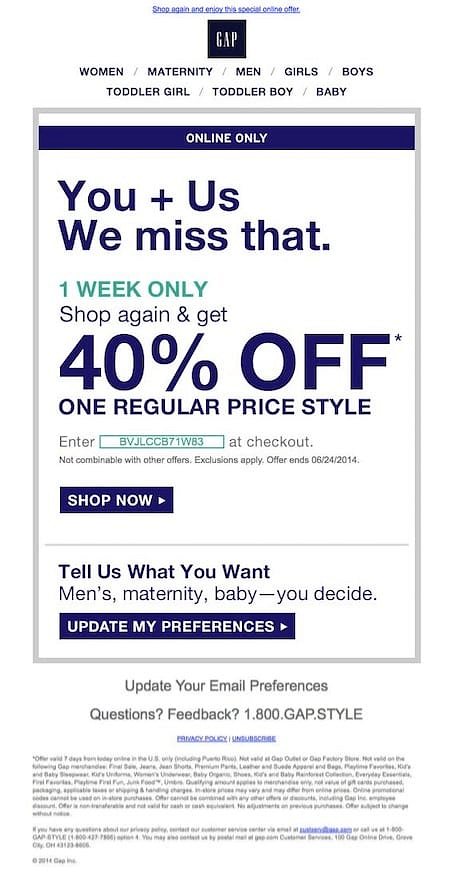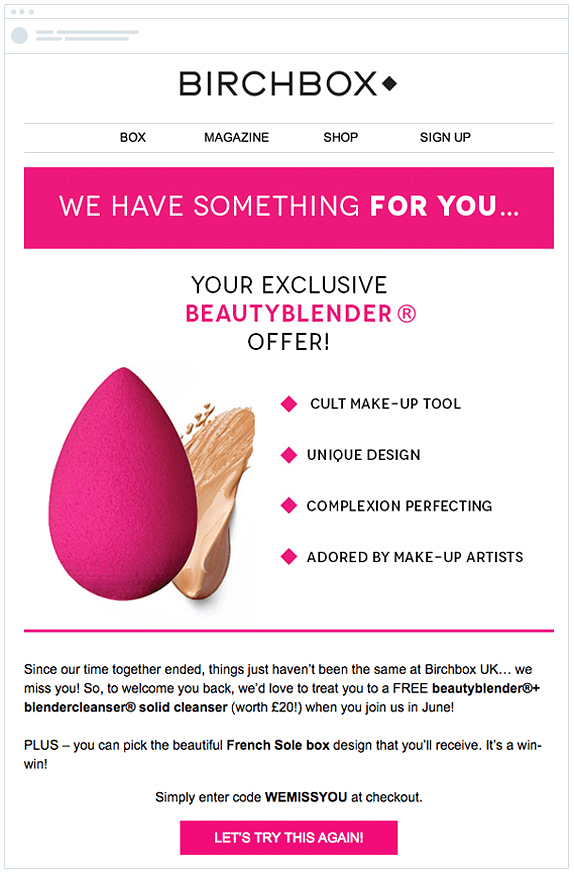Targeted Email Marketing: Definition, Benefits, and Tips to Increase CTR
While using email segmentation to play the “long game” (i.e., drip sequences to build a relationship with your audience) is vital to the ongoing success of your business, you also need to know how to target specific customers to spur immediate sales, as well.
That said, today we’re going to focus on using email segmentation strategies that will allow you to create targeted emails that nudge your customers to take action without delay.
In looking to use targeted email marketing to directly impact sales, it’s important to segment your customers by Average Order Value first, then further segment them based on the factors we’ll discuss momentarily.
Reason being:
The offers you present in your emails—whatever they might be—need to fall within your target customer’s average price range if you want them to take action quickly.
In fact, your goal should be to provide offers your audience values highly at a price they’d consider shockingly affordable. In doing so, you’ll increase the chances of making a sale simply because the value of your offer is too good to pass up.
If we’re looking strictly at the factors that influence a consumer’s purchasing decision, the price of a product, service, or offer is always a main concern. So, in creating a segmentation strategy for your targeted marketing campaign that improves sales, you should always consider your customers’ AOV and other metrics related to their spending habits before dividing them up any further.
Table of Contents
What is a Targeted Email?
You want to make the best use of your mailing list and segmentation strategies by sending emails that are tailormade to fit the buying needs of the targeted subscriber. These emails are meant to make the subscribers feel special by delivering value every single time. A targeted email is an email that will help you achieve that.
The ultimate goal of any email campaign is to eventually get the recipient to make a purchase.
As we said earlier, sometimes the plan is to create a workflow that includes drip sequences that nurture prospects toward conversion over time. Other times, it’s best to cut right to the chase, taking advantage of potential sales opportunities as quickly as they come about.
In other words, you need to know:
- Who, specifically, you’re targeting
- When is the optimal moment to target them
- What to offer them when reaching out
A targeted email marketing campaign makes use of this information to enable you to deliver the right email to the right person at just the right time to get them to convert.
Benefits of a Targeted Email Campaign
Regardless of the industry you are in or the type of emails you send, targeted emails can be used to get more returns from your email marketing efforts.
It's based on the logic that a targeted email caters to 5 essential components & outcomes of any email. These are:
Relevance: When you will send targeted email, you will be sending only emails that resonate with a particular segment. Your subscriber segments will receive less content that's not relevant to them and hence the unsubscribe rate will go lower. Your subscribers will remember you as a brand that's made for them and will come back to you for more information or products.
Response: When the image, copy, style, send time etc., of your email are targeted to a particular audience, there is a high chance they will relate to it and will respond by taking the action you specified.
Relationship: Targeted emails help build a relationship with your audience because when they like the message, take an action and look forward to your emails, they are also likely to tell their friends about it as if you are something they trust and have a bond with.
Revenue: The one big mistake marketers make it talk about the right topic to the wrong people. But with targeted emails, you have narrowed your subscriber base and tailored your messaging accordingly. This will get them to read, take action, trust you and hence buy from you.
Retention: Even past customers are a segment and likely know a lot about you. So when the messaging for them is targeted around new offers, or something exclusive for customers only etc., they are more likely to come back and shop again. So you can see how targeted email marketing will help retention.
How to Create a Targeted Email Marketing Campaign
Creating a targeted email campaign is a 4 step process:
Check your database: First of all, take a note of the kind of data you have in your emails. To create good segments, you should know about your customers as much as possible - demographics (gender, location, age), personal details (name, birth date),purchase history, activity level, interests etc.
The best way to collect this data is through your subscription form or regular surveys. Each purchase should be tied to an email address, even if it's happening in your physical store or through referrals.
Define your segments: Next, after looking at the data, you should define which segments make sense. If you don't have enough data on location then you shouldn't create a segment with location category. Or if you think gender has no role to play in your messaging, (which is rare by the way) then you shouldn't segment according to that.
So define segments in a way that it will help you deliver relevant content to them & a uniform email will not work.
Create your segments: The next step is to actually go into your email marketing software and create these segments. Every ESP will have its own process to create these segments. These will be separate from lists.
Craft your email: Then you will choose your business objective & the segment you want to talk to and craft an email tailored to them. For example, if your aim is to increase footfall of ladies in your store in NYC, you will choose the segment where subscribers are women in NYC and create an email resonating with them.
Test & analyse: Finally, as we always say, don't just follow best practice but also test if they are working for you. What we told here are steps that generally apply to all businesses. But do keep checking with the help of data if these are creating any business returns or brand-engagement.
The first step to creating targeted emails:
Defining your audience by creating advanced mailing list segments.
Let’s talk about the segments you’ll want to create.
Send Targeted Emails to Increase CTR and Open Rates
Let’s take a look at the five segmentation strategies that will allow you to create targeted emails that will get your customers to take action right away.
1. By Your Customer’s Stated Needs
Whether it be to accomplish a goal, overcome an obstacle, or fix a problem, all of your customers come to you for a reason.
Of course, not everyone has the same reason for doing business with your company. And, the more products or services you offer, the more varied these reasons will be.
So, it just makes sense to segment your audience based on the value they hope to receive from your brand. In turn, you’ll be able to present highly-relevant offers to each of your prospective customers whenever you reach out to them.
For example, though Net-A-Porter sells a variety of clothing and fashion items, the company often focuses its emails on singular themes for specific audiences based on their expectations:


Now, in order to actually present targeted offers to your various customers from the get-go, you need to learn as much as you can about them from the onset of your relationship with them. In providing questionnaires and other such surveys for your new customers as you bring them onboard, you can place them in certain value-based audience segments almost immediately.
(It’s also worth noting that Net-A-Porter allows its customers to customize the emails they receive from the company—allowing the team to further segment its audience accordingly.)
In terms of spurring sales, it’s a no-brainer:
The more relevant the offers in your promotional emails are to your specific customers’ needs, the more likely your audience will be to take advantage of them (leading to a potentially massive increase in sales and revenue for your business).
But, you can only provide such targeted offers if you know what your specific customers are looking to get from your brand. Segment your audience based on their needs from the get-go, and you’ll always be able to deliver targeted emails that your individual customers simply can’t resist.
2. By Purchase Frequency and Routine
It’s no secret that a customer’s purchase frequency goes hand-in-hand with their value to your business.
But, for the purpose of increasing sales across the board, we’re going to focus on the idea of segmenting your entire audience by their purchase frequency, then delivering specific offers at just the right time to get your customers to bite.
In other words, it’s not about identifying and focusing on just your most-frequent buyers. Rather, the goal is to get all of your customers purchasing just a little bit more every time they come to you—and to get them to make these purchases just a little more frequently, too.
Say, for example, you have a customer who purchases the same product from you, in the same quantity, every single Saturday morning. You could then create a weekly promotional email to be sent to this individual on Saturday before they make their usual purchase, promoting product discounts and upgrades, supplementary items, and other relevant offers.

The benefit here is two-fold: For one, the email acts as a gentle reminder, all but ensuring the customer will continue with their routine purchase. Secondly, it increases the chances of the customer increasing their spend in this transaction—and, ideally, in future transactions as well.
In identifying your customers’ purchasing patterns and habits, then creating emails that align with these patterns, you’ll be able to engage with your individual customers at just the right time to get them to convert.
In getting this timing down, you’ll inevitably increase your audience’s average purchase frequency—and, potentially, their average order value—across the board.
3. By Lack of Engagement
The other side of understanding your customers’ purchase frequencies is being able to identify when they’ve become less active as patrons of your brand.
The goal here is to get your at-risk customers back on track, keeping their purchase frequency and AOV as close to the status quo as possible.
(And, of course, if you can increase these metrics, all the better.)
You can actually create three different segments, here:
- One-Time Delinquents: Those who “skip” a usual purchase session
- At-Risk Customers: Those who have clearly broken from their routine with your brand, but still make infrequent purchases
- Lost Customers: Those who no longer patronize your business
Of course, you’ll need to tailor your approach to each of these segments accordingly.
For example, you might provide first-time “skippers” a discount on their first refill:

For at-risk customers, you’ll want to hit them with relevant and high-value offers—and learn more about what they’re looking for from your brand:

In targeting former customers who have all but shut the door on your relationship, you have one last chance to get back in their good graces. Here, you might offer personalized discounts or targeted freebies to those who decide to continue patronizing your brand.

By segmenting your audience based on your risk of losing them, you can deliver enticing, personalized offers via email that will get even your most disengaged customers back on track. Segmenting customers on the basis of their engagement levels can also help you build better and improved email lists!
4. By On-Site Behavior (or Inaction)
For a moment, think about the many ways your customers engage with your website (and your brand, overall).
There’s a lot to think about, right?
A few examples:
- Customer A visits your home page, watches a product demo, then leaves your site
- Customer B navigates to a product category page, then checks out a handful of product pages—but doesn’t make a purchase
- Customer C goes right to a specific product page, adds the item to their cart...but doesn’t actually complete their order
- Customer D visits a product page, adds the item to their cart, and completes their order in a single session
Each of these scenarios presents an opportunity for you to increase sales via email—as long as you know how to target the customer in the first place. You can use tools such as chatbots to gather relevant data related to your visitors’ on-site behavior.
You might send those like Customer A discount offers on the product whose demo they checked out. Customer B’s email might provide bundle offers for related products they were browsing, or product comparisons (with links to each product page, of course). Customer C would get the trusty ol’ cart abandonment email, while Customer D might get relevant cross-sell offers in the near future.

The goal is to identify and segment common behaviors that are indicative of a customer’s needs and expectations, and that present high-quality sales opportunities for your brand. Figure out what these behaviors are, and you can begin developing highly-relevant emails to be delivered to those who fit the bill.
5. Take a Holistic Approach to Targeted Email Marketing
We’ve been weaving our last piece of advice through this article, but now let’s make it crystal clear:
Using just one of these segmentation strategies for your targeted email marketing campaigns alone won’t be enough to spur sales.
Your customers won’t always shop for products that align with their typical purchase history; your repeat customers won’t all be susceptible to upsell and cross-sell offers; not all cart abandoners will respond the same way to being sent a 10% discount.
The point is, whether you’re writing emails for brand awareness, promotion, or after sales service—Context matters.
After all, context is what enables us to get ultra-granular with our approach to a targeted email marketing campaign. Rather than forgetting everything else we know about our audience, it’s important to use all that we know to get as close to the “segment of one” as you can.
To illustrate our point, consider a scenario in which two customers of a pet food store both abandon their shopping carts—one of which was full of cat food, the other full of dog food.
If we were to simply segment these individuals as “cart abandoners,” they each would receive the same targeted email—albeit with their respective products in cart, and potentially some dynamically-generated product suggestions for each.
But, we can further identify these customers as cat- and dog-owners, respectively. So, we might decide to create two separate abandoned cart emails—one cat-themed and one dog-themed—providing a more personalized experience for both customers in the process. In turn, we’ll likely have a higher chance of getting both cart abandoners back on track toward conversion.
Of course, this is just one way to “mix and match” your audience segments to develop targeted email campaigns that spur sales. And, to be sure, you don’t have to create email segments for all possibilities and permutations of your audience.
But, you do need to determine which of these possible permutations are profitable to target for your business. It’s all about identifying the specific circumstances in which conversion is probable for a specific individual—and sending just the right email to seal the deal.
Wrapping Up
While not every targeted email you send out should be focused on selling, you want the ones that are to be as effective as possible.
That, right there, is why using audience segmentation to create targeted emails is crucial for increasing ecommerce sales via email.
The more specific your segments—be them by personas, behaviors, or both—the easier it will be to reach out to just the right person, at just the right time, with just the right offer to get them to convert.
All said and done, to execute this effectively, well, you need an email marketing software. We recommend that you try SendX, which comes with a free 14-day trial (no credit card required).


